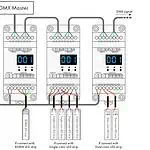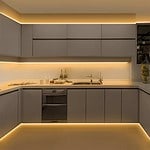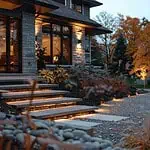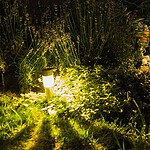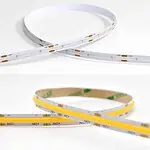Outdoor LED strip lights come with higher IP ratings that can withstand the moist environment of the garden. You can use these lights around the garden beds and pathways, as well as highlight big plants, plant shades, ponds, fountains, and seating areas in the garden.
To know how and where to install outdoor LED strip lights in your garden in the right way, keep reading:
Is It Safe To Use Outdoor LED Strip Lights In the Garden?
Using outdoor LED strip lights in the garden is completely safe. These lights are designed to withstand harsh environmental conditions like rain, storms, wind, dust, and moisture. In garden areas, the LED strips have to go through frequent water contact, soil, wind, etc. To protect the light in such surroundings, using higher IP-rated light is a must.
For indoor gardens or outdoor gardens with decorative shelters, a minimum IP44-rated light is essential. However, depending on the contact with water and dust, the required IP rating for garden lights can be higher, such as IP65, IP67, or IP68. You will get complete water and dust protection by choosing outdoor LED strip lights with IP68 ratings. These lights are suitable for ponds, pools, or underwater garden features.
Guide To Choose LED Strip Lights For Garden
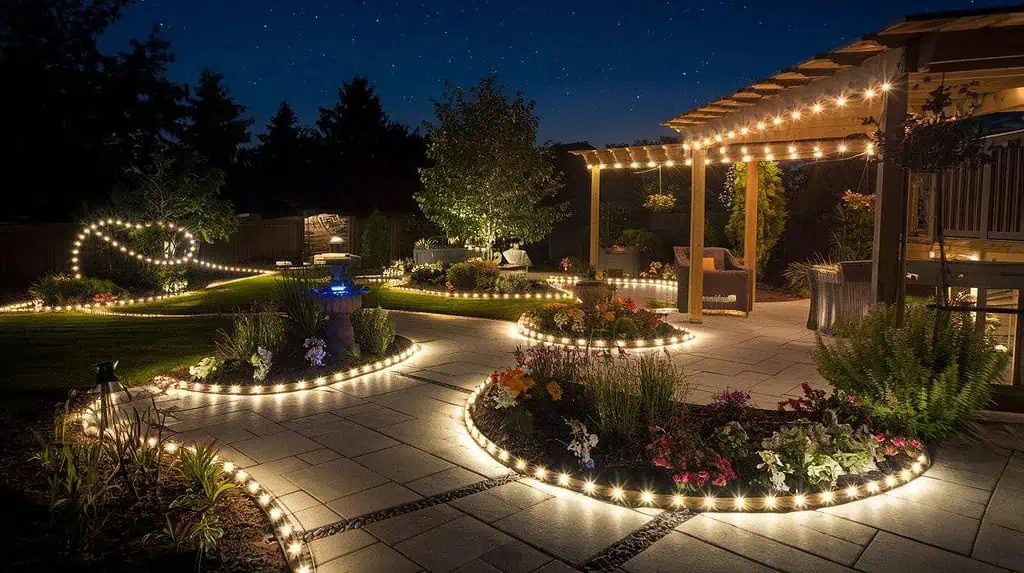
1. Size Of The Garden To Decide on LED Strip Length
Unlike other LED lights, LED strip lights are measured in length instead of bulb number. So, considering the size or area of the garden is crucial here. First, mark the areas of the garden where you want to install the LED lights and take measurements. Based on the measurement, calculate the length of the LED strip you require.
Standard LED strip lights usually come as 5 meters/reel. So, considering the size of the garden, you can easily determine how many reels you need. However, LED strip lights are available in different lengths other than the standard 5 meters/reel.
2. Light Color: Single or Multicolor
To beautify your garden, choose a light color that fits the ambiance well. LED strips are available in a wide range of colors and variants to fit all your needs. For residential gardens and hospitality areas like hotel and restaurant gardens, warm-tone LED strip lights are excellent. You can use single-color LED strip lights for such areas; popular colors for garden lighting include- yellow, red, green, blue, amber, pink, etc.
However, if you want to bring more fun to your garden lighting, go for RGB LED strip lights. These fixtures offer multicolor options. You can change the color of the lights to match your mood. Such lighting is excellent for children’s park gardens and other entertaining areas.
3. Brightness Level
Too bright light can negatively impact the plants of the garden. Again, if the light is too dim, it won’t provide sufficient visibility in the garden. You should mainly focus on proper visibility to ensure safe walking through the garden at night time. For this, go for at least a brightness level of 100-200 lumens per square meter.
Besides, for accent lighting in certain areas, a low-lumen LED strip of 50-150 lumens is enough. This will bring a soft glow to your garden and make it look more appealing at night. Nevertheless, the area or size of the garden is also a crucial factor when choosing the brightness of the LED strips.
4. LED Strip Density
LED strip lights are available in varying densities. This indicates the spacing between each LEDs organized over the PCB of the strip light. Higher density means more uniform and brighter lighting. On the other hand, low density means more space between LEDs, which offers less uniform lights, and often, the gaps are visible when the light is lit.
| LED Density | Effect | Suitable Garden Application |
| Low Density (30-60 LEDs per meter) | Soft and gentle lighting effect | • Accent lighting for gardens • Border lighting along garden paths |
| Medium Density(60 -120 LEDs per meter) | Offers brighter lighting, ideal for medium-sized gardens | • Lighting up small trees • Lighting around gardens and flower beds |
| High Density (120+ LEDs per meter) | Focused, uniformed and dramatic lighting | • Highlighting larger trees and outdoor sculptures |
5. Voltage
LED strips are low-voltage lights. They are usually available in 12V and 24V options. However, you must consider the need for voltage increment as the length of the strip extends. For example, a 12V LED strip will show an optimal length of up to 5 meters. If you extend the length more than this, it will face voltage drop issues. As a result, the brightness of the light will no longer remain uniform throughout the strip length. Therefore, for continuous runs, considering the length of the LED strip is crucial. The below chart of voltage in correspondence to strip length will help you pick the correct voltage for your garden lights:
| Voltage | Length Of The LED Strips |
| 12V/24V | 5-meter/reel |
| 24VDC | 20-meter/reel |
| 36VDC | 30-meter/reel |
| 48VDC & 48VAC/110VAC/120VAC/230VAC/240VAC | 50-meter/reel |
| 48V Constant Current | 60- meter/reel |
However, you can easily cut the length of the LED strips or extend the length by joining multiple strips using connectors or by soldering. However, if you are using low-voltage LED strips to join multiple LED strips, power injection will be needed at certain points to minimize voltage drop.
6. IP Rating
For outdoor garden lighting, IP rating is the most important thing to consider. IP stands for Ingress Protection. It determines the light’s resistance against solid and liquid ingress. A higher IP rating means the light can withstand water, moisture, dust, air and wind better. So, to ensure the LED strip is used in outdoor gardens, you must use high IP-rated LED strip lights.
| IP Rating | Protection Level | Best For |
| IP44 (at least) | Protection against objects >1 mm and water splashes | Garden areas that have shelter and don’t face direct rain contact |
| IP65 | Dust-tight and resistant to water jets | Garden beds, pathways and areas exposed to rain/splashes. |
| IP67 | Dust-tight and can handle temporary immersion in water | Areas facing heavy rainfall or featuring water bodies like fountains or ponds |
| IP68 | Dust-tight and suitable for continuous immersion | Lighting up garden areas that remain submerged under water, such as lighting under ponds or water bodies |
7. IK Rating
What if, while watering the plants, the heavy metallic garden jug falls on the LED strip lights? There is an obvious chance of light damage. To protect your fixture from such sudden accidents, considering high IK-rating is crucial. IK stands for Impact Protection; it determines the LED strip’s resistance level against impact. IK rating is graded from 00 to 10. A higher IK means more excellent resistance against impact or hit. However, an IK06 or IK07 is enough for garden and pathway lighting.
8. Controllers & Dimmers
If you want greater control over your outdoor garden lighting, choose LED strips with dimmers and controllers. This allows you to dim the light and thus adjust the brightness of your garden illumination as per the requirement. Besides, if you are using RGB LED strips and controllers, you can change the color of the light and bring a vibrant mood to your garden space.
9. Cost
The cost of the LED strip depends on its type, length, density, lumen rating, CRI, IP rating, power consumption, and more. If you are purchasing RGB strip lights, it will cost you more than single-color LEDs. Again, for greater density, higher IP/IK rating, and power consumption, the price of the LEDs will increase. Moreover, the brand of the light also matters. Branded and export-quality LED strip lights have a standard market price compared to cheaper local qualities. So, make up your budget and research well to purchase high-quality LED strips at competitive pricing.
10. Warranty & Certifications
To ensure the best quality LED strips check on the certification. This ensures international standards and laboratory testing. Some essential certifications to consider for LED strip lights include:
- UL certificate
- CE certificate
- RoHS certificate
- ELT certificates
- LM80 test report
- CB and CE certificates, and more
Besides, consider an extended warranty for more reliability. A 3 to 5-year warranty is great for LED strip lights.
How to Use Outdoor LED Strip Lights in Your Garden?- Stepwise Guide
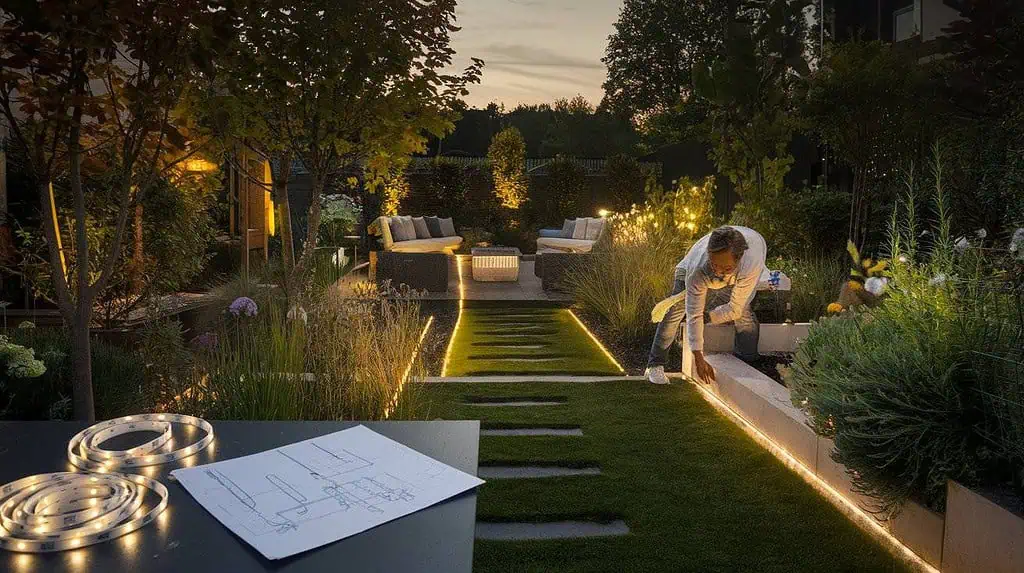
Step 1: Choose The Right LED Strip
Determine the length of the LED strip and the light color you need. Also, consider the required IP, IK, and voltage ratings for your lighting. This will help you pick the right strip lights. Besides, dimming facilities and color-changing features should also be considered for better control over garden lighting. However, before finalizing your LED strip, check on the manufacturer’s certification, warranty, and test reports for purchasing from reliable manufacturers.
Step 2: Plan The Layout For Lighting Garden
Select the areas you want to light up, take measurements, and size the LED strips accordingly. You can easily cut the LED strips using scissors to size them to fit the area. Besides, if needed you can also join the LED strips together to extend the length.
Step 3: Install The LED Strips
Plan cable routes within the garden beds where you want to place the LED strips. Use aluminum channels and adhesive backing to set the LED strips in the desired locations. If you make any cuts while installing the LED strips, seal them with silicone glue to ensure it remain waterproof.
Step 4: Power Up
Next, connect the LED strips to the LED driver. In this step, ensure the wattage of the LED strip is compatible with the driver. For best results, use a power supply that can handle at least 20-30% more wattage than the total load. And the driver you use must be waterproof and designed for outdoor usage.
Step 5: Test
Turn on the light and check whether the light glows. If the lights don’t turn on, check the wiring and power supply. Then try turning on the lights again.
Common Issues With Garden LED Strip Lighting and Solutions
1. Uneven Lighting Across The LED Strip
Due to extending the length of the LED strip or insufficient power supply, the LEDs show voltage drop issues. As a result, as the length runs away from the power supply, the voltage gradually reduces, and so is the brightness of the light.
Solution:
- Inject power on specific points when joining multiple LED strips together
- Use high-voltage LED strips
- Ensure compatibility between the wattage and voltage of the LED strip and power supply.
2. Water Damage
Garden lights are more prone to face water places or direct water contact. If you use a low IP-rated LED strip light, water contact will surely damage it. Even if you use waterproof LED strips, not sealing them after cutting or wiring lets water enter the LED. This eventually damages the LEDs or affects their performance.
Solution:
- Use higher IP-rated LED strips- IP65, 67, or 68.
- Seal all connections with silicone or waterproof connectors.
3. LED Strips Peeling Off or Falling
An unplanned and weak adhesive backing causes the LED strips to fall or peel off from the installation area.
Solution:
- Use outdoor graded adhesive, connectors, and clips
- Clean and place the lights in a dry surface for better adhesion
4. Color Shift or Inconsistencies
Poor quality LEDs or voltage issues cause shifts in LED color. This also occurs due to the use of incompatible components like controllers, strips, and power supplies with LED strips. As a result, you don’t get the expected light color.
Solution:
- Use branded and high-quality LED strips
- Ensure all components (controller, strips, power supply) are compatible
- Consider certification and tests like LM80
5. LED Strips Not Lighting Up
Using damaged LED strips will not light up after the power supply. It can also cause the power supply with incorrect voltage and wattage. Moreover, if there is any faulty or loose wiring, the lights will not turn on.
Solution:
- Ensure secure and correct wiring
- Use a driver with appropriate voltage and power supply with the LED strip
Top 7 Ideas To Use Outdoor LED Strip Lights In Your Garden
1. Highlight Pathways
Make the pathways of your garden feel like the way to heaven by outlining them with LED strips. You can easily borderline the routes by choosing your desired strip light color. However, to bring a cozy ambiance, warm-tone LED strip lights work best. In addition to LED strip lights, you can also incorporate LED bollard lights on the sides of the pathways.
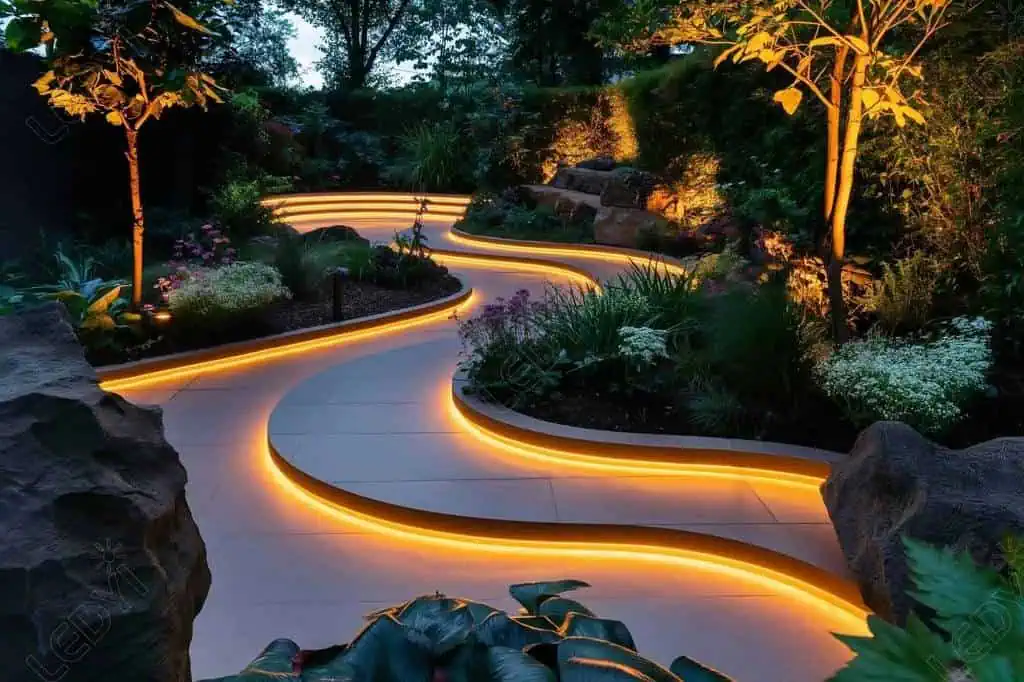
2. Outline The Garden Beds
Highlighting your garden beds will pop up the small plants in your garden. It will further uplift specific sports around your garden and make it look more appealing. You can choose colorful LED strip lights to bring a playful vibe. To enhance the lighting, try adding small globe lights in different spots around the garden bed.
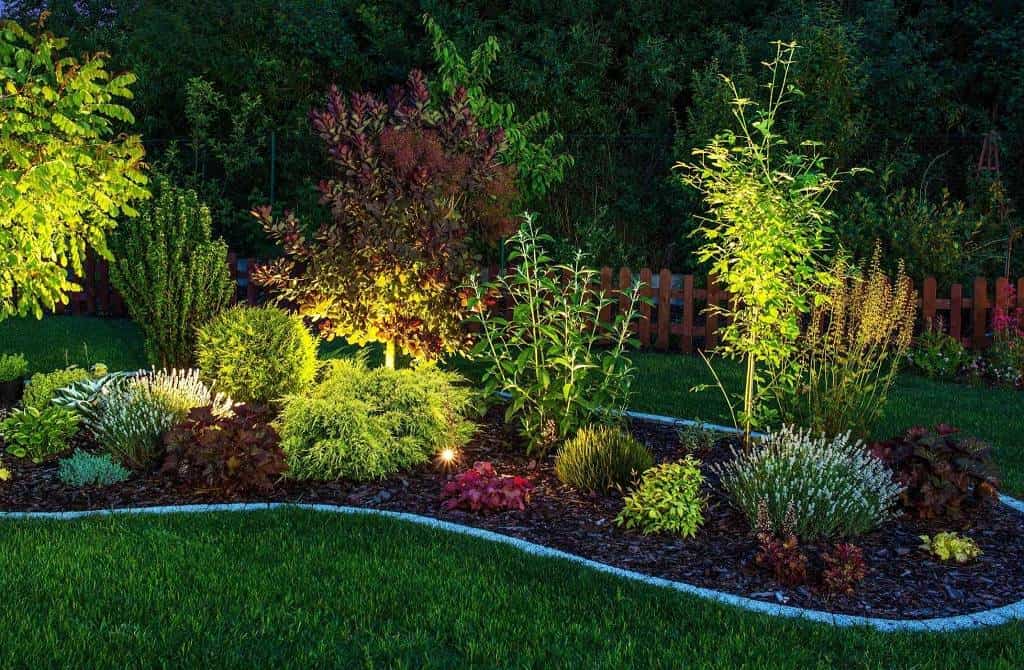
3. Accentuate Water Features
In exclusive garden areas in five or seven-star hotels or luxurious resorts, gardens are often incorporated with water features like ponds and fountains. Using waterproof LED stripe lights to highlight these water features will add an ornamentation effect to your garden. Blue LED strip lights fit best for lighting water bodies. However, use IP68-rated lights for this purpose and choose high-density strips for an even finished light output.
4. Decorate Seating Areas
Installing LED strip lights underneath the seating area of the garden will elevate the space. It further adds a floating effect to the garden. You can hang out with your friends and family in your garden sitting here. To bring an inviting atmosphere, go for warm LED strip lights. Besides, if you are more into the party vibe and keep celebrating occasions in your garden area, go with RGB LED strips. This allows you to change the light color to fit your mood.
5. Light Up Decks and Patios
Decks and patios of the garden area bring you multiple options to use the LED strip lights. Add them to the under-railing to create a floating effect. Besides, adding these lights on the steps of the decks will highlight the stairs areas. More options to install LED lights include- adding lights on the deck perimeter and underneath seats.
6. Highlight Tree or Plant
LED strip lights are very flexible to give the desired shape. This opens up the option to go for creative lighting. You can quickly outline them around large trees and create a lit tree boundary. This works great for large trees in your garden. You can also light small plants using the same method.
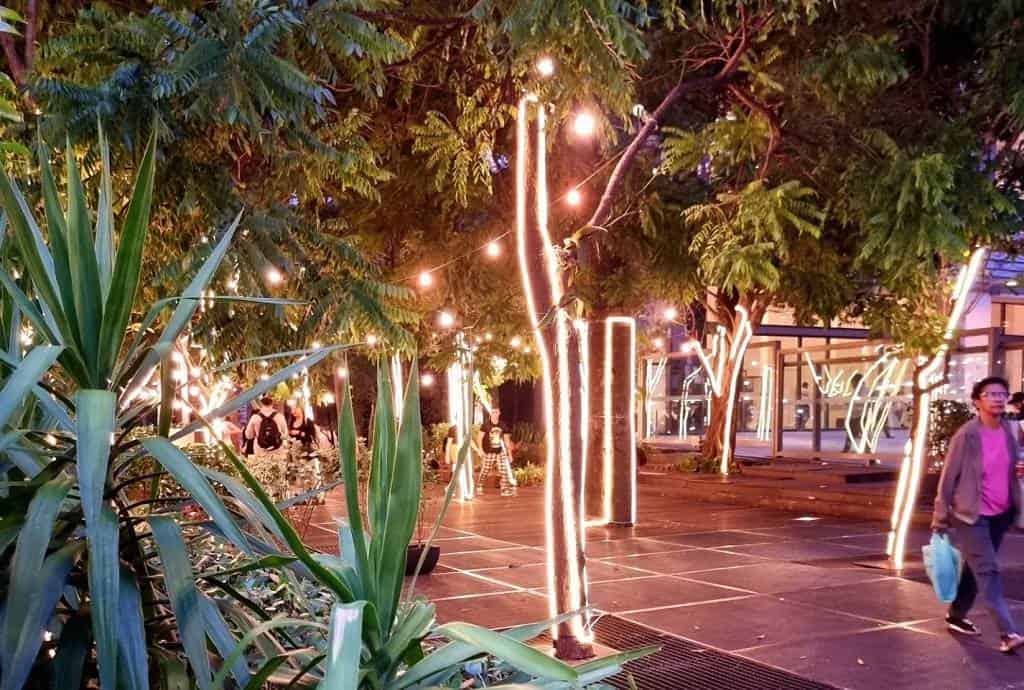
7. Use for Vertical Gardens
Vertical gardens on walls of your indoor or outdoor areas add aesthetic appeal to your space. Using LED strip lights to po-up these plants is a great move. You can outline them or irregularly place them on different parts of the vertical garden to bring a unique output. The illumination of the strip lights popping up from the plants creates a mysterious effect on your garden.
FAQs
LED strip lights have an average lifespan of 50,000 hours. However, while using them outdoors, make sure they are designed for outdoor use and have a higher IP rating. With proper maintenance, you can use the strip lights for much longer.
LED strip lights are low-power lights and don’t generate much heat. Moreover, they are highly energy-efficient, so keeping them one for all night won’t raise the electricity bill as it will for traditional lighting. However, keeping the lights on unnecessarily is never suggested as it is a misuse of energy.
LED strips use minimal electricity. Where traditional lights like incandescent transform 20% of electrical energy to light, LEDs utilize more than 80% for light conversion. This makes LEDs highly energy efficient. Using electricity, LEDs can produce brightness similar to that of traditional lights.
Bugs are attracted to lights, but the color of the light is crucial. Using cool white or blue LED strip lights increases the chances of bug attacks. However, you should go for warm-tone lights like yellow, orange, or red. Bugs are less likely to be attacked by these long wavelength lightings.
LED strip lights overate at low power and do not generate much heat. So they are safe to use in gardens or around plants. However, a wrong installation or placing the lights too close to the plant can burn them.
Yes, LED strip lights are suitable for plants. However, instead of using random LED strips, use ones specially designed for plants, mostly known as LED grow lights. These LED strips are designed as per the essential light wavelengths that help plants grow. You will get better results in horticulture using these lights for both vegetative and flowering stages.
Wrapping
The super flexibility of the LED strips allows you to install them in gardens in different creative ways. You can use aluminum channels and clips to mount the LED strip lights on the garden bed and vertical gardens or simply wrap the strips around trees. However, the voltage, IK, and IP rating of the LED strip lights are very crucial when using them outdoors.
LEDYi LED strip lights bring you all different types of LED strip lights suitable for outdoor gardens. You can choose an IP rating that fits your requirements. Moreover, we offer you customization facilities and a 3 to 5-year warranty on our strip lights. So, contact us to place your order now!
